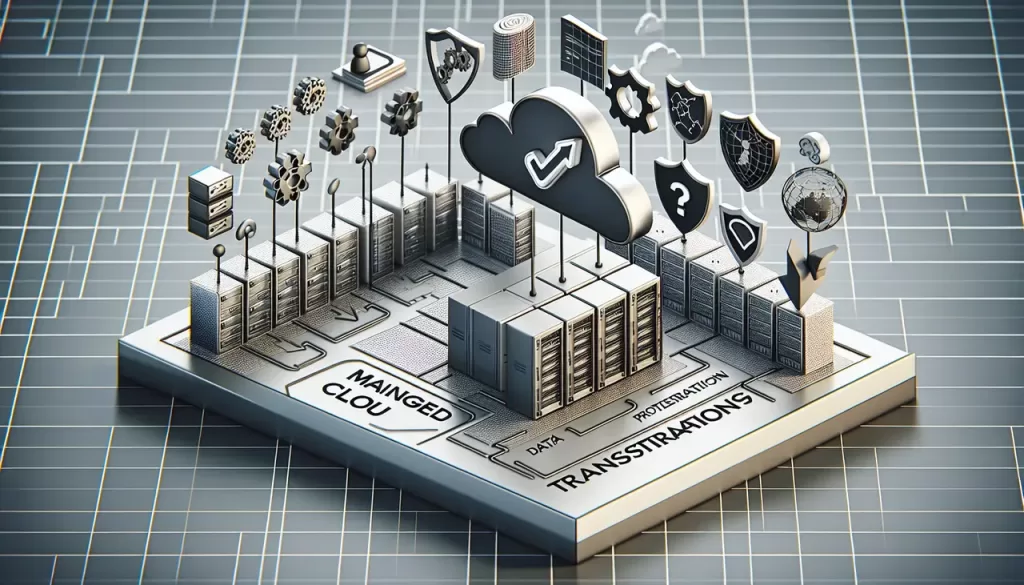Understanding Managed Cloud: A Quick Overview
Managed cloud is like hiring a team of experts to take care of your company’s cloud computing needs. Think of it as outsourcing your IT department for everything cloud-related. Instead of figuring out the ins and outs of cloud storage, security, and computing by yourself, managed cloud services do the heavy lifting. This means they handle your data, run your applications, and manage storage on cloud platforms. They also make sure everything is secure and running smoothly. With managed cloud, your business can tap into advanced cloud technologies without needing an in-house cloud expert. It’s a smart move for businesses looking to get the benefits of the cloud while focusing on what they do best.

Self-Assessment: Is Your Business Ready for Managed Cloud?
Before diving into the world of managed cloud, it’s crucial to gauge if your business is truly ready for this transition. Here’s a straightforward checklist to help you assess your readiness:
- Understand your current IT infrastructure: Do you constantly struggle to manage your servers, storage, and networks? If there’s more frustration than functionality, it might be time to consider a switch.
- Evaluate your in-house expertise: Does your team have the skills required to migrate to and manage a cloud environment? If not, are you willing to invest in training or to hire someone who does?
- Consider your business goals: What do you aim to achieve by moving to the cloud? Whether it’s scaling your resources, enhancing security, or improving efficiency, your objectives should align with the benefits managed cloud offers.
- Budget wisely: Can you allocate funds for this transition without straining your finances? Remember, it’s not just about the migration costs but also ongoing expenses for cloud services.
- Security and compliance needs: Are you in an industry with strict data protection and privacy regulations? If yes, ensure the cloud service provider can comply with these requirements.
If you’ve ticked off these points, your business might just be ready to embrace the managed cloud. However, it’s always a good idea to consult with a cloud services provider to get a more detailed assessment tailored to your specific needs.
Key Benefits of Moving to a Managed Cloud Service
Switching to a managed cloud service can seem like a huge deal, but it’s packed with perks that can really boost your business. First off, it saves you a truckload of time and headache by letting experts handle the tech stuff. This means you can focus on what really matters – growing your business. Plus, it’s a testament to reliability. With a managed cloud, your data is backed up across multiple locations, so even if one server decides to take a vacation, your information doesn’t vanish. Security? It’s top-notch. Managed cloud services are like having your own digital bodyguard, protecting your data from cyber threats around the clock. And let’s talk money. It might sound pricey upfront, but it actually saves you cash in the long run. No need to spend big on an IT team or fancy hardware. The managed cloud wraps all those costs into one predictable monthly fee. Lastly, scalability is a breeze. As your business grows, your managed cloud can grow with it, ensuring you’re always running at peak performance without having to overhaul your system. So, eyeing for efficiency, security, and cost savings? A managed cloud service might just be your business’s new best friend.
Analyzing the Costs: Managed Cloud Investment
Shifting to managed cloud services sounds pricey, right? But let’s break it down. Initially, yes, it may seem like a big chunk of your budget. You’re not just paying for air. You’re investing in expertise, security, and scalability. The cost varies widely based on what services you need, the size of your operation, and the provider you choose. Typically, companies spend anywhere from $500 to thousands monthly on managed cloud services. However, consider the savings on in-house IT staff, reduced downtime due to expert management, and the potential for scaling your resources up or down as needed. Plus, many hidden costs come with managing your cloud in-house—like security breaches or inefficiencies, which can add more to your bill than you might think. Overall, it’s a balancing act. You pay more upfront and regularly, but the trade-offs can be worth it if you value reliability and growth.
Technical Considerations for Managed Cloud Transition
When thinking about shifting your business to a managed cloud, the technical side of things is crucial. First off, examine your current IT infrastructure. Ask yourself, is it complex? Understanding its complexity will help you gauge the effort needed for migration. Next, consider data security. With the cloud, protecting sensitive information becomes a collaborative effort between you and the provider. Ensure they offer robust security measures that align with your needs. Integration is another big player. Your existing tools and applications must seamlessly sync with the cloud services, ensuring business operations continue without hiccups. Also, ponder scalability. The beauty of the cloud is its flexibility to grow with your business but confirm that the managed cloud solution can scale up (or down) as needed. Lastly, don’t neglect compliance. If your industry has strict regulations, your managed cloud service must adhere to these to keep you on the right side of the law. Taking these technical aspects seriously will smooth out your transition to a managed cloud and set the stage for success.
Security and Compliance in the Managed Cloud
When you move to the managed cloud, security and compliance must top your list of concerns. The good news? Managed cloud providers focus heavily on these areas, often offering more robust security than what you could muster with an in-house team. First off, let’s talk data protection. Providers use cutting-edge encryption and intrusion detection systems to guard your data. But here’s the kicker — they also handle pesky software updates and patches, which means fewer vulnerabilities for hackers to exploit.
Compliance is another biggie. Whether you’re under the watchful eyes of GDPR in Europe or HIPAA in the U.S., your managed cloud provider knows these regulations inside out. They make sure your data handling practices tick all the legal boxes, saving you from hefty fines and reputational damage.
Remember, though, not all providers are created equal. Do your homework. Check their credentials. Ask about their security measures and compliance track record. The right provider will not only meet your current needs but also anticipate future challenges, keeping you one step ahead in the security game.
Choosing the Right Managed Cloud Provider
Picking the right managed cloud provider is a big decision. It’s about finding a partner that fits your business like a glove. Look for a provider who talks your language, understands your goals, and has the tech chops to back it up. Think about the support you need. Do you want someone on call 24/7? Or is a helpdesk ticket system enough for you? Reputation is king. Read reviews, ask for case studies, and chat with their existing customers. Make sure they’re up to scratch in security and compliance, especially if you’re in a field where that’s non-negotiable. And finally, think about the future. Pick a provider who can scale with you, adapting as your business grows. It’s not just about where you are now, but where you’re heading.
Planning Your Managed Cloud Transition: A Step-by-Step Guide
Starting your move to a managed cloud service sounds daunting, but it doesn’t have to be. First, understand why you’re making the shift. Is it for better security, more flexibility, or perhaps cost efficiency? Nail down your reasons. Next, evaluate your current setup. What do you have in-house? What’s working, and what’s not? This step is crucial. Then, think budget. Managed cloud doesn’t mean free cloud. Know what you’re willing to spend. After that, it’s about picking the right partner. Not all cloud services are created equal. Look for one that aligns with your goals and offers the support your business needs. Finally, plan the migration. Decide what moves first and what follows. Consider running a pilot project to iron out kinks. Remember, communication with your team is key throughout this process. Step by step, you’ll make a successful transition to managed cloud.
Training Your Team for a Smooth Managed Cloud Integration
Getting your team up to speed is crucial for a seamless transition to managed cloud services. The process isn’t just about tech upgrades; it’s about people. To ensure your staff can navigate the new cloud environment efficiently, focus on comprehensive training programs. Start by identifying the key areas where your team needs the most guidance—this often includes data security, cloud management tools, and specific software applications your business will use. Once you’ve pinpointed these areas, you can tailor your training sessions to meet these needs. Remember, hands-on sessions trump lectures every time. So, make sure your training includes plenty of opportunities for your team to use the cloud services actively. Another smart move is to designate “cloud champions” within your team. These are individuals who grasp the new technology more quickly and can help guide their colleagues through the transition. This peer support can dramatically reduce the learning curve and foster a more collaborative atmosphere. Lastly, remember that training for managed cloud integration isn’t a one-time event. The cloud evolves, and so should your team’s skills. Implement ongoing training sessions to keep everyone’s knowledge fresh and to introduce new features or best practices. This ongoing education will help your business make the most out of its managed cloud investment.
Summary: Making the Decision and Next Steps
Deciding to switch to managed cloud isn’t just about following trends. It’s a strategic move that can cut costs, boost efficiency, and secure your data. But hold on, it’s not for everyone. Your business needs to be ready for the clouds — literally and figuratively. Picture this. It’s not just about having the budget. It’s about knowing what you want out of it. Is it about offloading IT chores? Or maybe scaling your operations fast without buying heaps of hardware? Once you’re clear on the “why,” the “what” and “how” become easier to tackle.
Here’s the crux. Start by auditing your current IT setup. What works? What’s as slow as a snail? This step is crucial. It tells you what you need and, importantly, what you don’t. Next, get your team on board. Cloud transitions are not just IT projects. They’re business projects. Every department needs to know the game plan.
Choosing the right partner is like picking a teammate in dodgeball. You want the best on your side. Look beyond fancy words. Check their track record. Do they get what your business is about?
Finally, plan for bumps. Yes, even the best plans hit a snag. Set aside some budget and patience for unforeseen issues.
In a nutshell, moving to a managed cloud is a big decision — but it doesn’t have to be a headache. Know what you need, pick the right help, and get everyone on board. Then, you’re set for smoother sailing.




